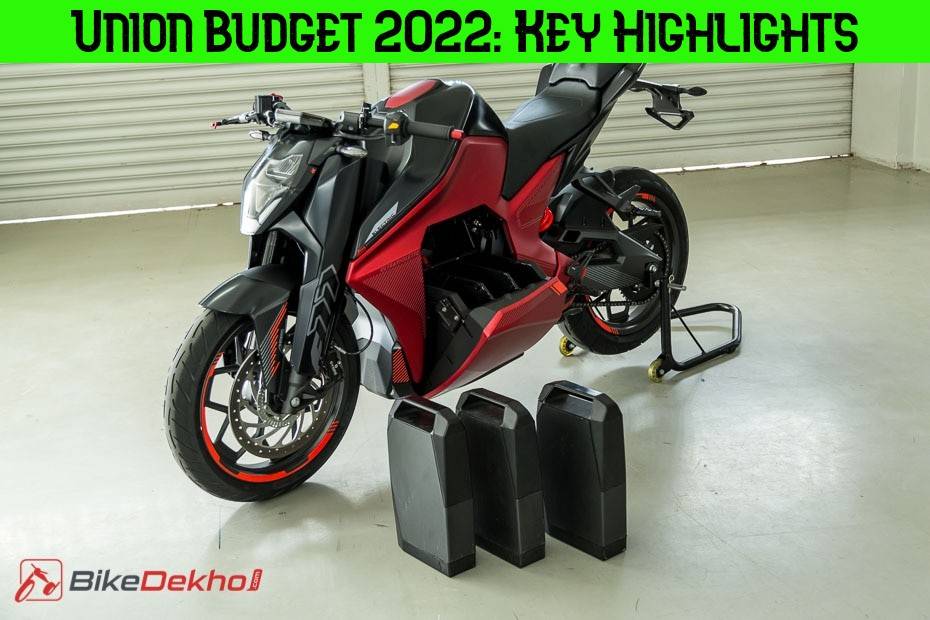Budget 2022: Top Highlights For Two-wheelers
Modified On February 1, 2022 15:09 IST
By Praveen M. for Revolt RV400
- 3481 Views
The Indian Government is betting big on swappable battery technology for electric vehicles and blended fuels for fossil fuel-powered ones

Finance Minister Nirmala Sitharaman presented the Union Budget for 2022 earlier today. As far as the auto industry is concerned, the government has focussed primarily on the fast-growing electric vehicle segment and the promising blended fuel space. Here are the key takeaways:
Betting big on swappable battery tech:

The Indian government seems to be bullish on swappable battery tech. Speaking about EVs, the Finance Minister said, “Considering the constraint of space in urban areas for setting up charging stations at scale, a battery swapping policy will be brought out, and interoperability standards will be formulated.”
She continued, “The private sector will be encouraged to develop sustainable and innovative business models for battery or energy as a service. This will improve efficiency in the EV eco system.”
In October 2021, Honda had revealed that it is already testing its swappable battery tech for the Indian market. Apart from the Japanese bikemaker, key players including Revolt Motors, Ultraviolette Automotive, and Bounce have an upper hand as they already have battery swapping technology mastered to some degree. This should help the companies save costs at least in chassis development when it comes to making electric two-wheelers with swappable battery tech.

Since interoperability standards are planned to be formulated by the government, we might just see a similar collaboration of two-wheeler makers in India, just like how KTM, Yamaha, Honda And Piaggio teamed up for developing a common battery swapping tech in Europe. This isn’t a new trend as even in Japan, the Big Four (Honda, Kawasaki, Suzuki, and Yamaha) had formed an agreement to standardise swappable batteries for electric motorcycles back in March 2021.
- Upcoming Bike Launches In February 2022: Royal Enfield Scram, Updated KTM RC 390, And More!
- Tork Kratos vs Revolt RV400: Photo Comparison
- Bajaj Chetak And TVS iQube Electric Sales: December 2021
It remains to be seen as to how players who are catering to fast-charging technology will adapt to this change. Ola Electric seems to be betting big on having its own wide network of fast-charging infrastructure, and in fact, aims to ultimately establish over 1 lakh charging points across 400 cities in India. Reinforcing its ambitions, the company recently received a Rs 1,500 crore funding, and also announced its investment of Rs 750 crore in a new development facility in the UK. Ather Energy also believes in fast charging technology. In fact, in August 2021, it even made its proprietary fast charging connector and its infrastructure shareable with other EV makers.

The primary concern for easy adoption of electric vehicles is the extended charging times, and battery swapping technology is the most effective approach in curbing this setback. However, setting up a large swapping station involves huge capital expenditure as manufacturers will have to invest in extra batteries over and above the ones that are already offered in their products. That said, forming a consortium should help reduce the fiscal stress in coming up with such a technology. It’ll be exciting to see how electric two-wheeler manufacturers react to this move.
Blended Fuels:

Speaking on blended fuel, Sitharaman said, “To encourage the efforts for blending of fuel, unblended fuel shall attract an additional differential excise duty of Rs 2 per litre from October 2022. A few other changes have been made in duty rates, customs tariff, and customs law, the details of which are there in the finance bill.”
Another viable short term solution to reduce dependency on fossil fuels is fuel blending. At the moment, ethanol blending is the most promising solution as it requires minimal modifications to the existing petrol-powered engines. The extra duty on unblended fuel should encourage fuel companies to focus more on blended ones. In our exclusive interview with Classic Legends’ CEO Ashish Singh Joshi, he had already revealed that enhancing the durability of certain parts of the engine will help run ethanol blended fuels effectively.

To know more about how ethanol and petrol powered engines are different, check out our analysis.
To sum up, the Union Budget has focussed more on battery swapping technology, but increasing FAME II benefits even further, along with reduced import duties for high-end EVs, would’ve made electrification a lot easier. Let us know what you think in the comments.
